TiCN Cermets with MnFeCoNiCu High Entropy Alloy Binder
Abstract
:1. Introduction
2. Materials and Methods
3. Results
3.1. Thermodynamic Calculations
3.2. Physical Properties
3.3. Investigation of Microstructures Using Optical Imaging
3.3.1. Variation of Cu Content
3.3.2. Increase in C/N Ratio and Reference Cermet
3.4. Investigations Using FESEM
3.4.1. Variation of Cu Content
3.4.2. Increase in C/N Ratio and Reference Cermet
3.5. Investigations Using EDS Mappings
3.6. X-ray Analysis
4. Discussion
5. Conclusions
Author Contributions
Funding
Data Availability Statement
Conflicts of Interest
References
- Lengauer, W.; Scagnetto, F. Ti(C,N)-Based Cermets: Critical Review of Achievements and Recent Developments. Solid State Phenom. 2018, 274, 53–100. [Google Scholar] [CrossRef]
- Pötschke, J.; Höhn, S.; Richter, V.; Mayer, M. Microstructural evolution during sintering of cermets studied using interrupted sintering experiments and novel 2D and 3D FESEM based techniques. Int. J. Refract. Hard Mater. 2017, 63, 47–54. [Google Scholar] [CrossRef]
- Ettmayer, P.; Kolaska, H.; Lengauer, W.; Dreyer, D. Ti(C,N)Cermets—Metallurgy and Properties. Int. J. Refract. Hard Mater. 1995, 13, 343–351. [Google Scholar] [CrossRef]
- ECHA. Substance Infocard: Cobalt. Available online: https://echa.europa.eu/de/substance-information/-/substanceinfo/100.028.325 (accessed on 20 June 2023).
- ECHA. Substance Infocard: Nickel. Available online: https://echa.europa.eu/de/substance-information/-/substanceinfo/100.028.283 (accessed on 20 June 2023).
- European Commission. Critical Raw Materials Resilience: Charting a Path towards greater Security and Sustainability. Available online: https://ec.europa.eu/docsroom/documents/42849 (accessed on 20 June 2023).
- Pittari, J.J.; Murdoch, H.A.; Kilczewski, S.M.; Hornbuckle, B.C.; Swab, J.J.; Darling, K.A.; Wright, J.C. Sintering of tungsten carbide cermets with an iron-based ternary alloy binder: Processing and thermodynamic considerations. Int. J. Refract. Hard Mater. 2018, 76, 1–11. [Google Scholar] [CrossRef]
- Gries, B.; Prakash, L. Cobalt free binder alloys for Hard Metals: Consolidation of ready-to-press powder and sintered properties. H C Stark. 2007. [Google Scholar]
- Humphry-Baker, S.A.; Marshall, J.M.; Smith, G.; Lee, W.E. Thermophysical properties of Co-free WC-FeCr hardmetals. In Proceedings of the 19th International Plansee Seminar; Plansee SE: Reutte, Austria, 2017; p. HM19, p. 1–13. [Google Scholar]
- Hinners, H.; Konyashin, I.; Ries, B.; Petrzhik, M.; Levashov, E.A.; Park, D.; Weirich, T.; Mayer, J.; Mazilkin, A.A. Novel hardmetals with nano-grain reinforced binder for hard-facings. Int. J. Refract. Hard Mater. 2017, 67, 98–104. [Google Scholar] [CrossRef]
- Zhao, Z.; Liu, J.; Tang, H.; Ma, X.; Zhao, W. Investigation on the mechanical properties of WC–Fe–Cu hard alloys. J. Alloys Compd. 2015, 632, 729–734. [Google Scholar] [CrossRef]
- Hanyaloglu, C.; Aksakal, B.; Bolton, J.D. Production and indentation analysis of WC/Fe-Mn as an alternative to cobalt-bonded hardmetals. Mater. Charact. 2001, 47, 315–322. [Google Scholar] [CrossRef]
- Fernandes, C.M.; Vilhena, L.M.; Pinho, C.; Oliveira, F.J.; Soares, E.; Sacramento, J.; Senos, A. Mechanical characterization of WC–10 wt% AISI 304 cemented carbides. Mater. Sci. Eng. A 2014, 618, 629–636. [Google Scholar] [CrossRef]
- Tarraste, M.; Kübarsepp, J.; Juhani, K.; Mere, A.; Kolnes, M.; Viljus, M.; Maaten, B. Ferritic chromium steel as binder metal for WC cemented carbides. Int. J. Refract. Hard Mater. 2018, 73, 183–191. [Google Scholar] [CrossRef]
- Qian, C.; Li, K.; Guo, X.; Liu, B.; Long, Z.; Liu, Y. Effect of WC grain size on mechanical properties and microstructures of cemented carbide with medium entropy alloy Co-Ni-Fe binder. J. Cent. South Univ. 2020, 27, 1146–1157. [Google Scholar] [CrossRef]
- Soria-Biurrun, T.; Sánchez-Moreno, J.M.; Frisk, K. Experimental and theoretical study of WC-40Fe-20Co-40Ni. Int. J. Refract. Hard Mater. 2022, 102, 105719. [Google Scholar] [CrossRef]
- Prakash, L. A Review of the Properties of Tungsten Carbide Hardmetals with Alternative Binder Systems. In Proceedings of the 13th International Plansee Seminar, Plansee SE, Reutte, Austria, 24–28 May 2013; Bildstein, H., Eck, R., Eds.; Plansee Metall AG: Reutte, Austria, 1993; Volume 2. HM 9, 80–109. [Google Scholar]
- Ceratizit Catalog All Inserts. Available online: http://www.grasche.com/links/doc/Ceratizit-Catalog-All-Inserts.pdf (accessed on 20 June 2023).
- Yeh, J.-W.; Chen, S.-K.; Lin, S.-J.; Gan, J.-Y.; Chin, T.-S.; Shun, T.-T.; Tsau, C.-H.; Chang, S.-Y. Nanostructured High-Entropy Alloys with Multiple Principal Elements: Novel Alloy Design Concepts and Outcomes. Adv. Eng. Mater. 2004, 6, 299–303. [Google Scholar] [CrossRef]
- Ke, B.; Sun, Y.; Zhang, Y.; Wang, W.; Wang, W.; Ma, P.; Ji, W.; Fu, Z. Powder metallurgy of high-entropy alloys and related composites: A short review. Int. J. Min. Met. Mater. 2021, 28, 931–943. [Google Scholar] [CrossRef]
- Ruiz-Esparza-Rodriguez, M.A.; Garay-Reyes, C.G.; Estrada-Guel, I.; Garcia-Aguirre, K.A.; Guia-Tello, J.C.; Mendoza-Duarte, J.M.; Martinez-Sanchez, R. Effect of Sintering Temperature in Tungsten Carbides Bonded with High and Medium Entropy Alloys. Microsc. Microanal. 2022, 28, 2802–2804. [Google Scholar] [CrossRef]
- Straumal, B.; Konyashin, I. WC-Based Cemented Carbides with High Entropy Alloyed Binders: A Review. Metals 2023, 13, 171. [Google Scholar] [CrossRef]
- Fa, C.; Jungui, Z.; Shijia, L.; Keke, G.; Pinqiang, D.; Chao, L.; Xiaofeng, Z. The microstructure and high-temperature oxidation resistance of tungsten carbide with high entropy alloys as binder. J. Ceram. Soc. Jpn. 2022, 130, 477–486. [Google Scholar] [CrossRef]
- Luo, W.; Liu, Y.; Luo, Y.; Wu, M. Fabrication and characterization of WC-AlCoCrCuFeNi high-entropy alloy composites by spark plasma sintering. J. Alloys Compd. 2018, 754, 163–170. [Google Scholar] [CrossRef]
- Zhou, P.-F.; Xiao, D.-H.; Yuan, T.-C. Comparison between ultrafine-grained WC–Co and WC–HEA-cemented carbides. Powder Metall. 2017, 60, 1–6. [Google Scholar] [CrossRef]
- Li, X.; Wei, D.; Vitos, L.; Lizárraga, R. Micro-mechanical properties of new alternative binders for cemented carbides: CoCrFeNiW high-entropy alloys. J. Alloys Compd. 2020, 820, 153141. [Google Scholar] [CrossRef]
- Qian, C.; Liu, Y.; Cheng, H.; Li, K.; Liu, B. Effect of the carbon content on the morphology evolution of the η phase in cemented carbides with the CoNiFeCr high entropy alloy binder. Int. J. Refract. Met. Hard Mater. 2022, 102, 105731. [Google Scholar] [CrossRef]
- Soria-Biurrun, T.; Navarrete-Cuadrado, J.; Lozada-Cabezas, L.; Ibarreta-Lopez, F.; Martinez-Pampliega, R.; Sánchez-Moreno, J.M. Microstructure, mechanical properties and fracture behavior of NiCoCrTiAl and FeNiCoCr new alternative binders for WC based hardmetals. Int. J. Refract. Met. Hard Mater. 2022, 103, 105748. [Google Scholar] [CrossRef]
- Real, C.; Alcalá, M.D.; Trigo, I.; Fombella, I.; Córdoba, J.M. Fabrication and characterization of FeCoNiCrMn,(Al) high entropy alloy based (Ti,Ta,Nb)(C,N) cermet. Int. J. Refract. Met. Hard Mater. 2021, 101, 105694. [Google Scholar] [CrossRef]
- Prieto, E.; Vaz-Romero, A.; Gonzalez-Julian, J.; Guo, S.; Alvaredo, P. Novel high entropy alloys as binder in cermets: From design to sintering. Int. J. Refract. Met. Hard Mater. 2021, 99, 105592. [Google Scholar] [CrossRef]
- Wang, Z.; Du, J.; Su, G.; Sun, Y.; Zhang, C.; Kong, X. Microstructure, preparation and properties of TiC-Fe/ FeCoCrNiMn cermet with a core-rim structure. Vacuum 2022, 200, 110984. [Google Scholar] [CrossRef]
- Ezquerra, B.L.; Biurrun, T.S.; Cabezas, L.L.; Sánchez Moreno, J.M.; Lopez, F.I.; Pampliega, R.M. Sintering of WC hardmetals with Ni-Co-Cr-Ti-Al multi-component alloys. Int. J. Refract. Hard Mater. 2018, 77, 44–53. [Google Scholar] [CrossRef]
- Pötschke, J.; von Spalden, M.; Vornberger, A. Novel FeCoNiCuMn High Entropy Alloys as Binders for TiCN based Cermets. In Proceedings of the World PM 2022 Congress Proceedings, Lyon, France, 9–13 October 2022. [Google Scholar]
- Marković, B.; Živković, D.; Vřešt’ál, J.; Manasijević, D.; Minić, D.; Talijan, N.; Stajić-Trošić, J.; Todorović, R. Experimental study and thermodynamic remodeling of the Bi–Cu–Ni system. Calphad 2010, 34, 294–300. [Google Scholar] [CrossRef]
- Chychko, A.; García, J.; Collado Ciprés, V.; Holmström, E.; Blomqvist, A. HV-KIC property charts of cemented carbides: A comprehensive data collection. Int. J. Refract. Met. Hard Mater. 2022, 103, 105763. [Google Scholar] [CrossRef]
- Yasinskaya, G.A. The wetting refractory carbides borides and nitrides by molten metals. Powder Metall. Met. Ceram. 1966, 5, 557–559. [Google Scholar] [CrossRef]
- Pötschke, J.; Vornberger, A.; Gestrich, T.; Berger, L.-M.; Michaelis, A. Influence of different binder metals in high entropy carbide based hardmetals. Powder Metall. 2022, 65, 373–381. [Google Scholar] [CrossRef]
- Pötschke, J.; Dahal, M.; Herrmann, M.; Vornberger, A.; Matthey, B.; Michaelis, A. Preparation of high-entropy carbides by different sintering techniques. J. Mater. Sci. 2021, 56, 11237–11247. [Google Scholar] [CrossRef]
- Pötschke, J.; Dahal, M.; Vornberger, A.; Herrmann, M.; Michaelis, A. Production and Properties of High Entropy Carbide Based Hardmetals. Metals 2021, 11, 271. [Google Scholar] [CrossRef]
- Anwer, Z.; Vleugels, J.; Datye, A.; Zhang, S.; Huang, S. Influence of varying carbon content in (V,Nb,Ta,Ti,W)C high entropy carbide—Ni based cermets on densification, microstructure, mechanical properties and phase stability. Ceram. Int. 2023, 49, 4997–5012. [Google Scholar] [CrossRef]
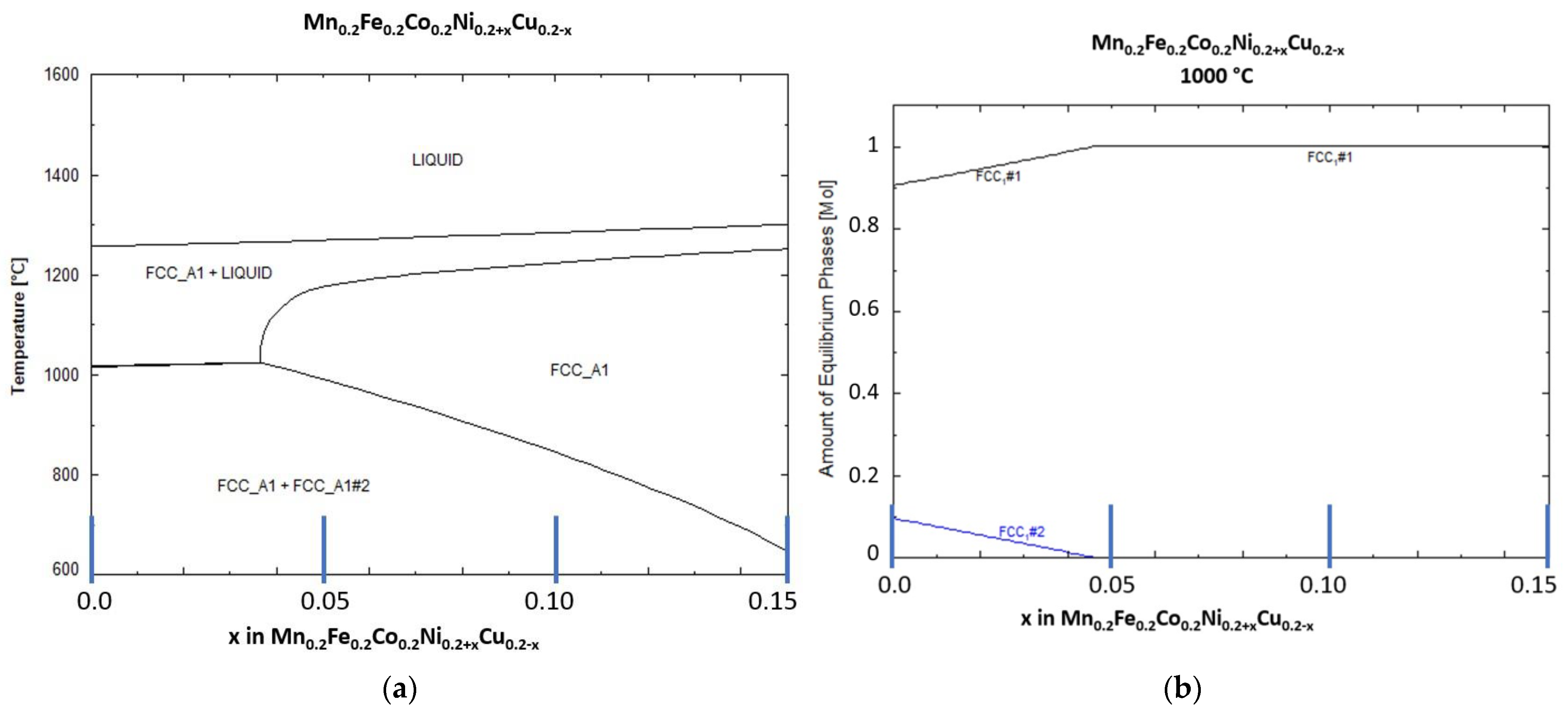
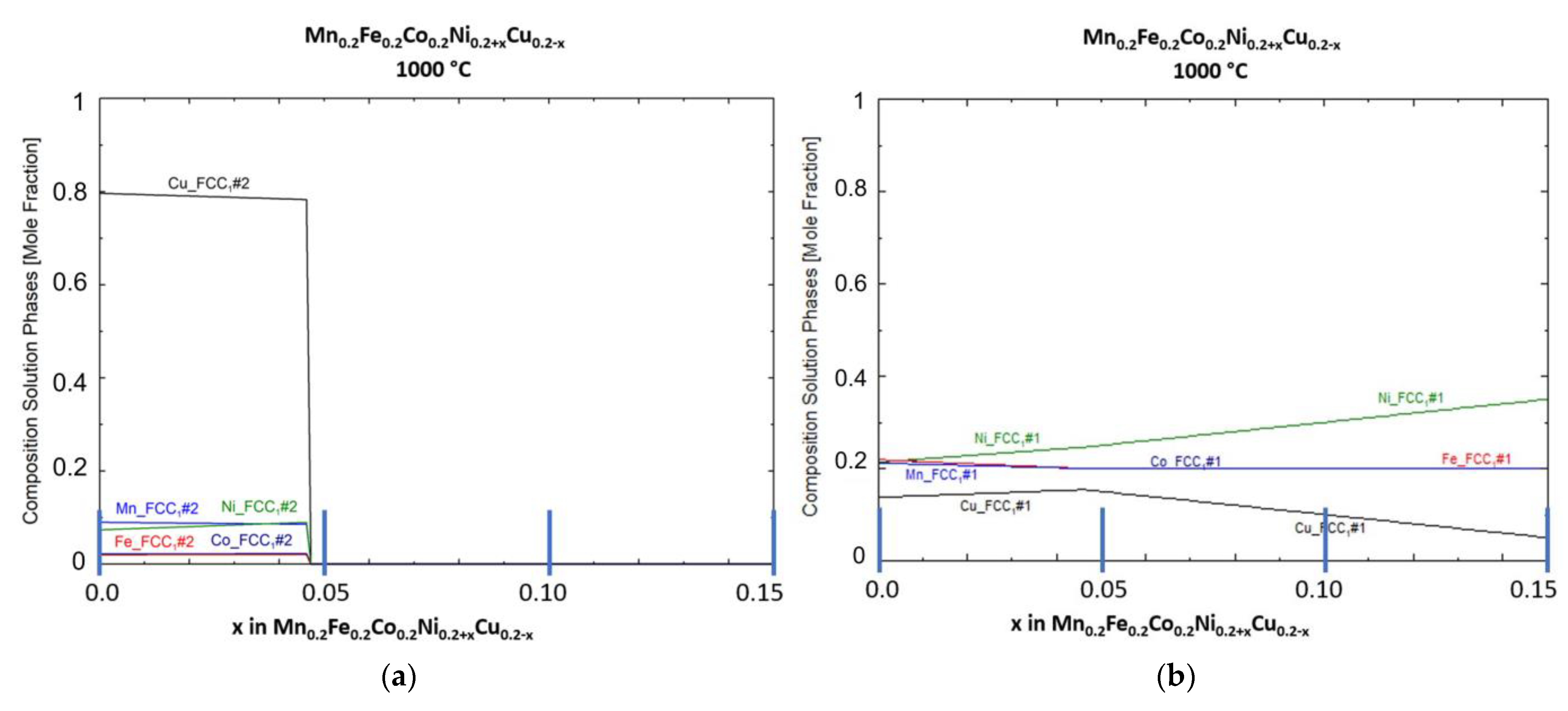
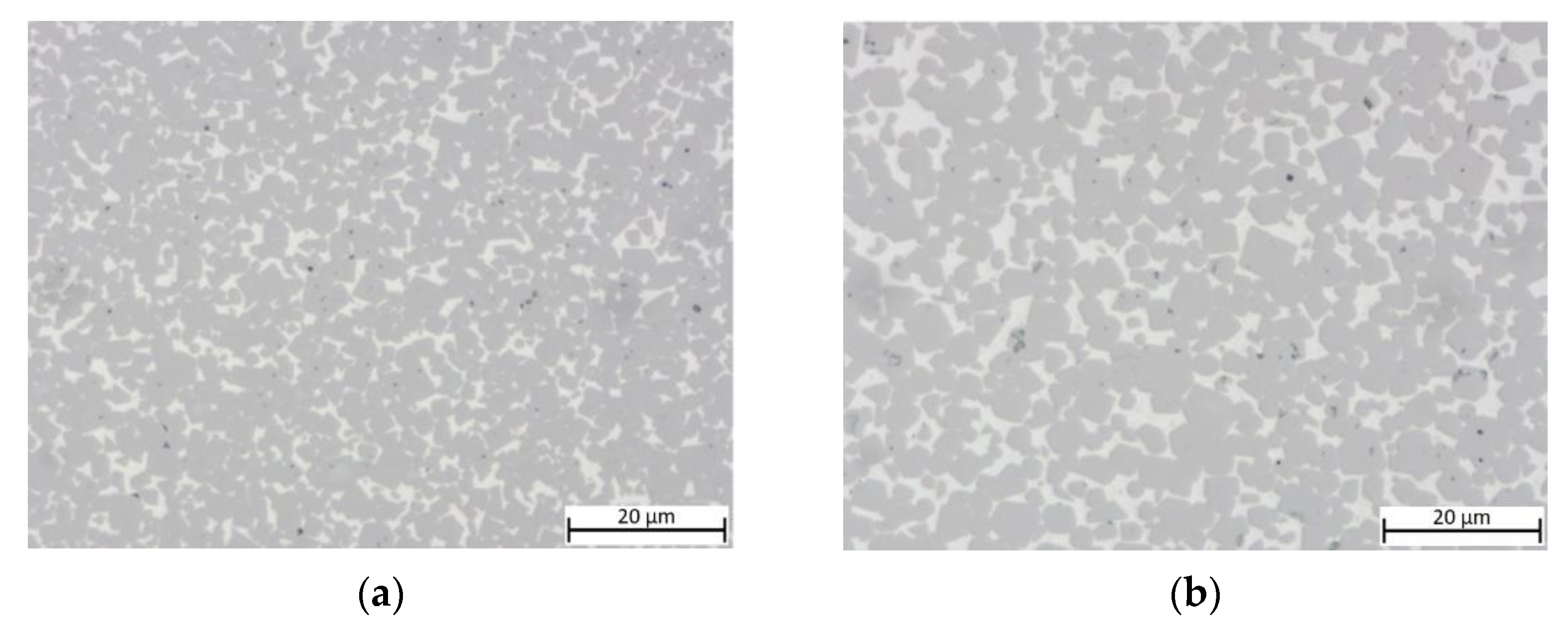

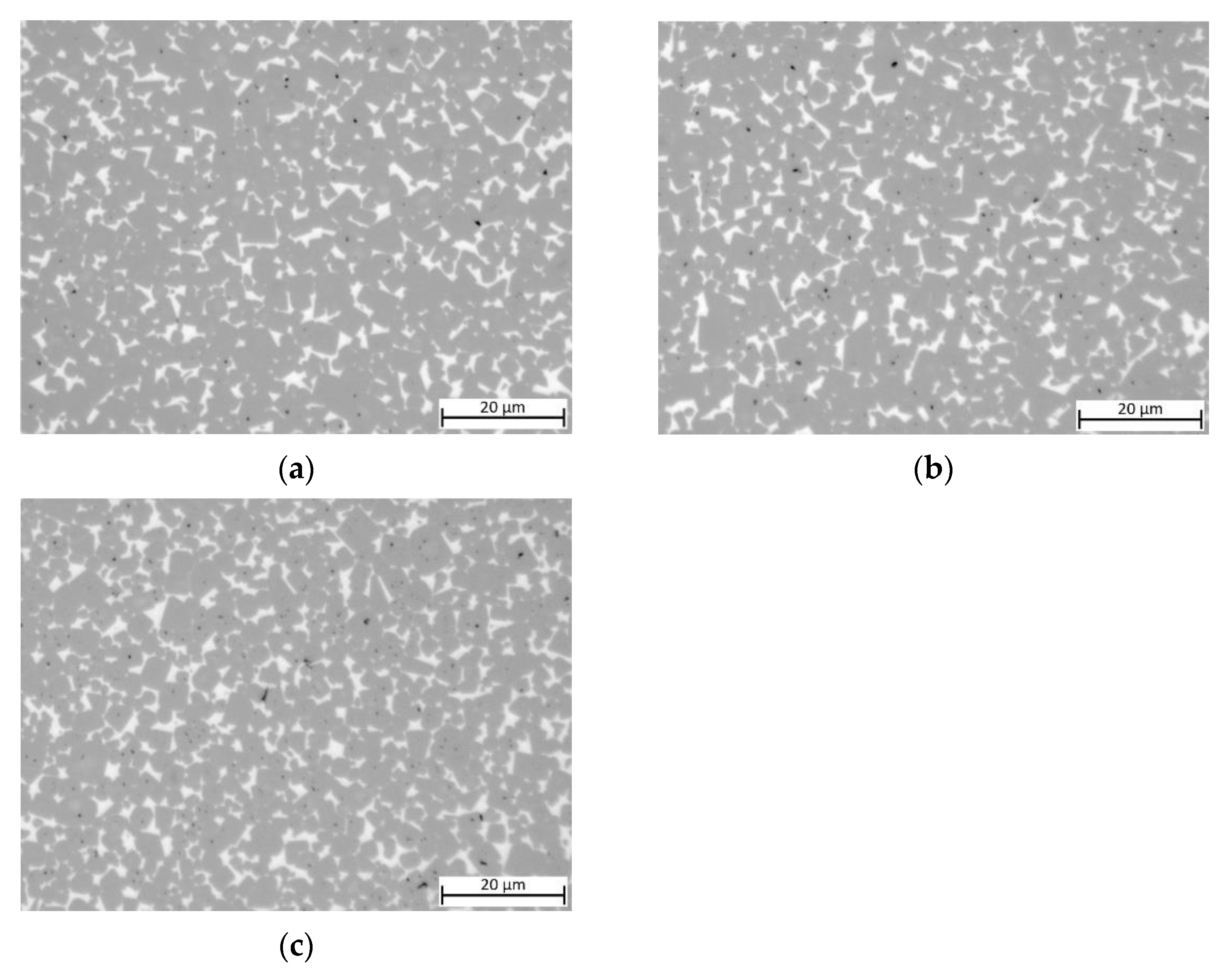
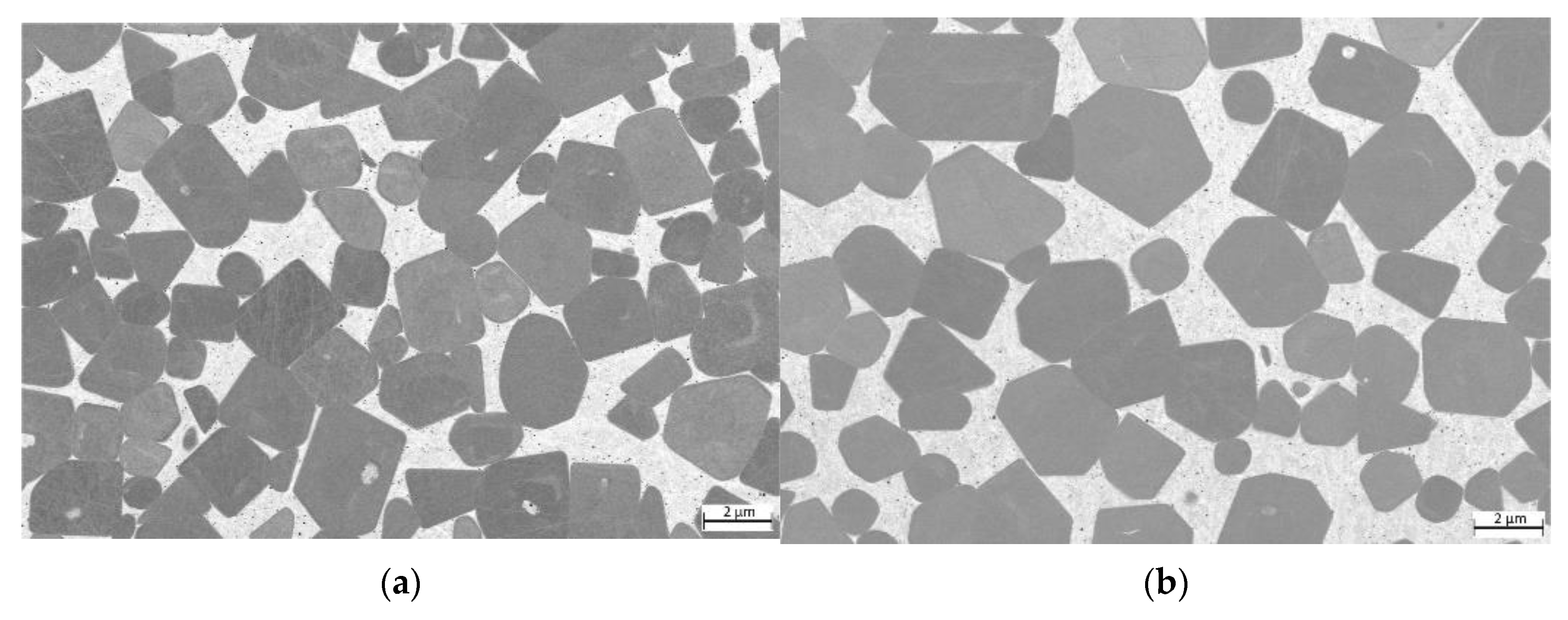
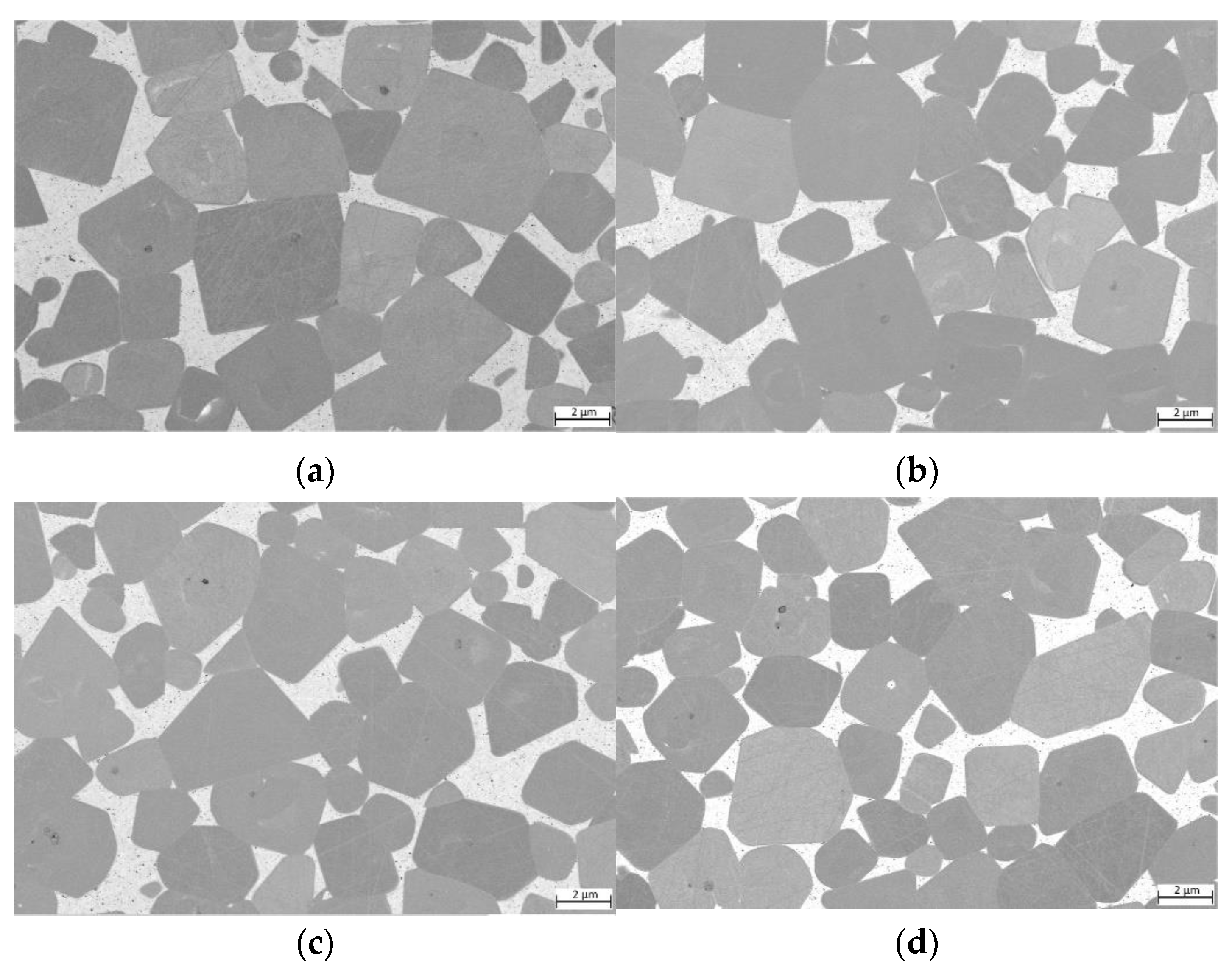

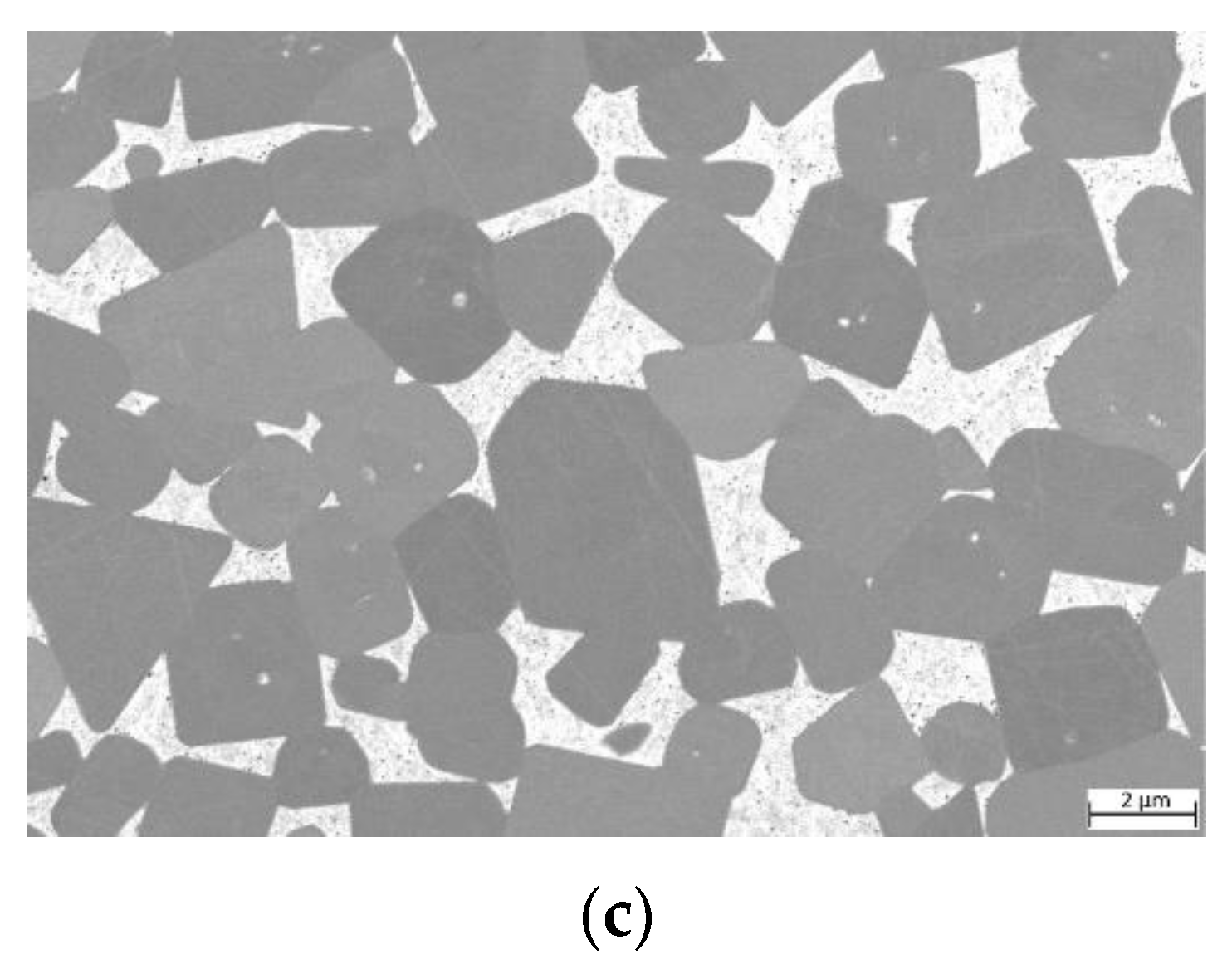

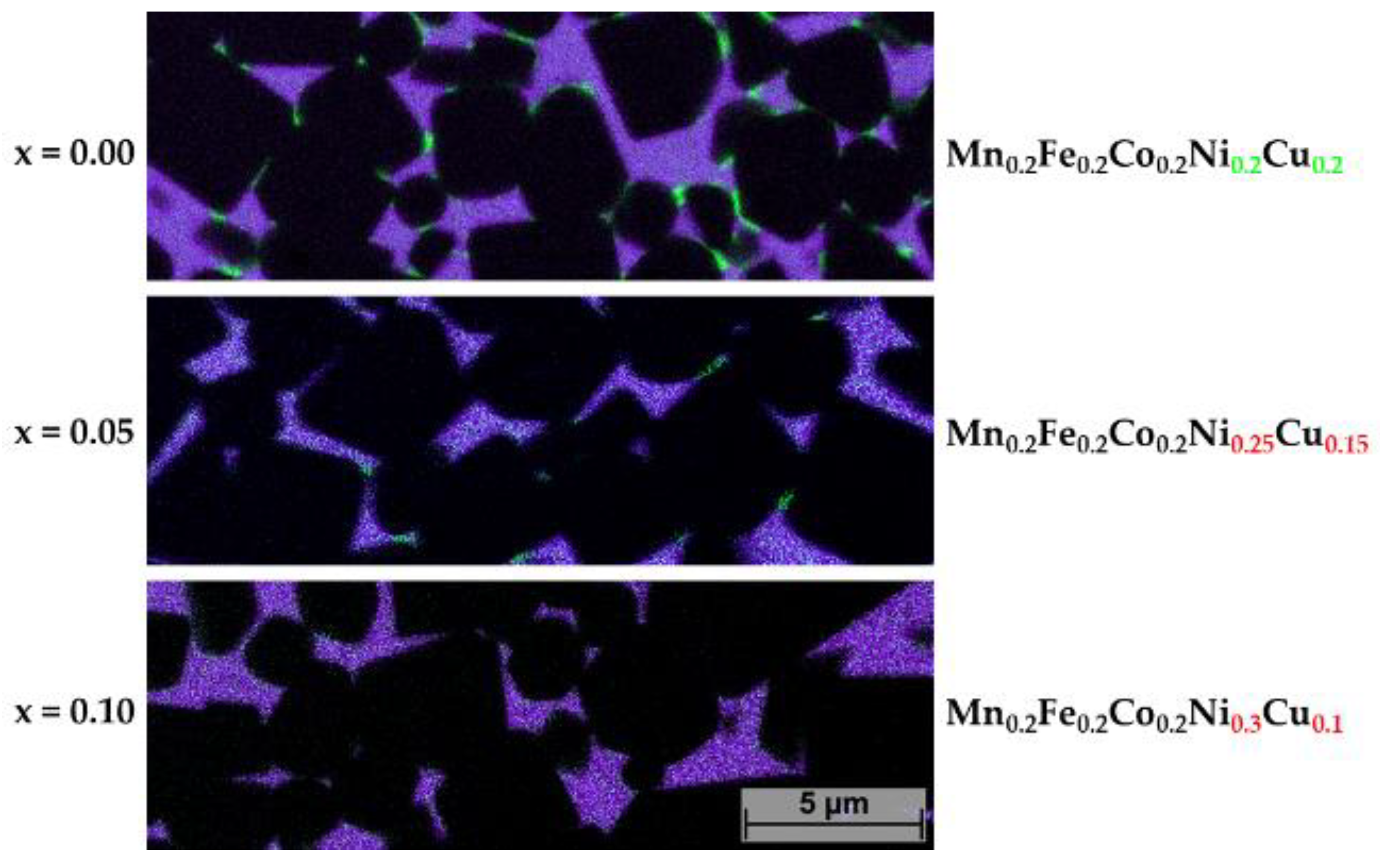
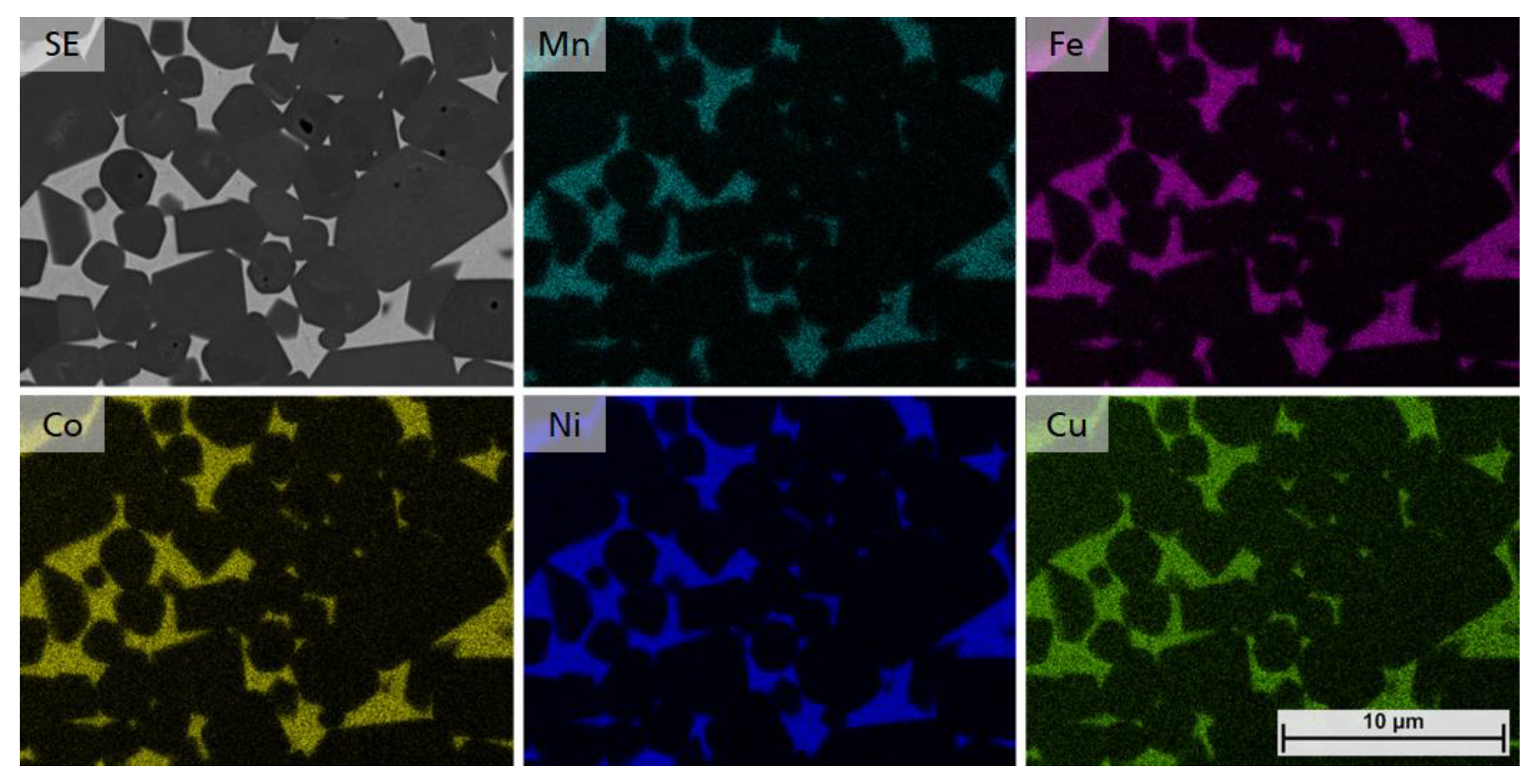
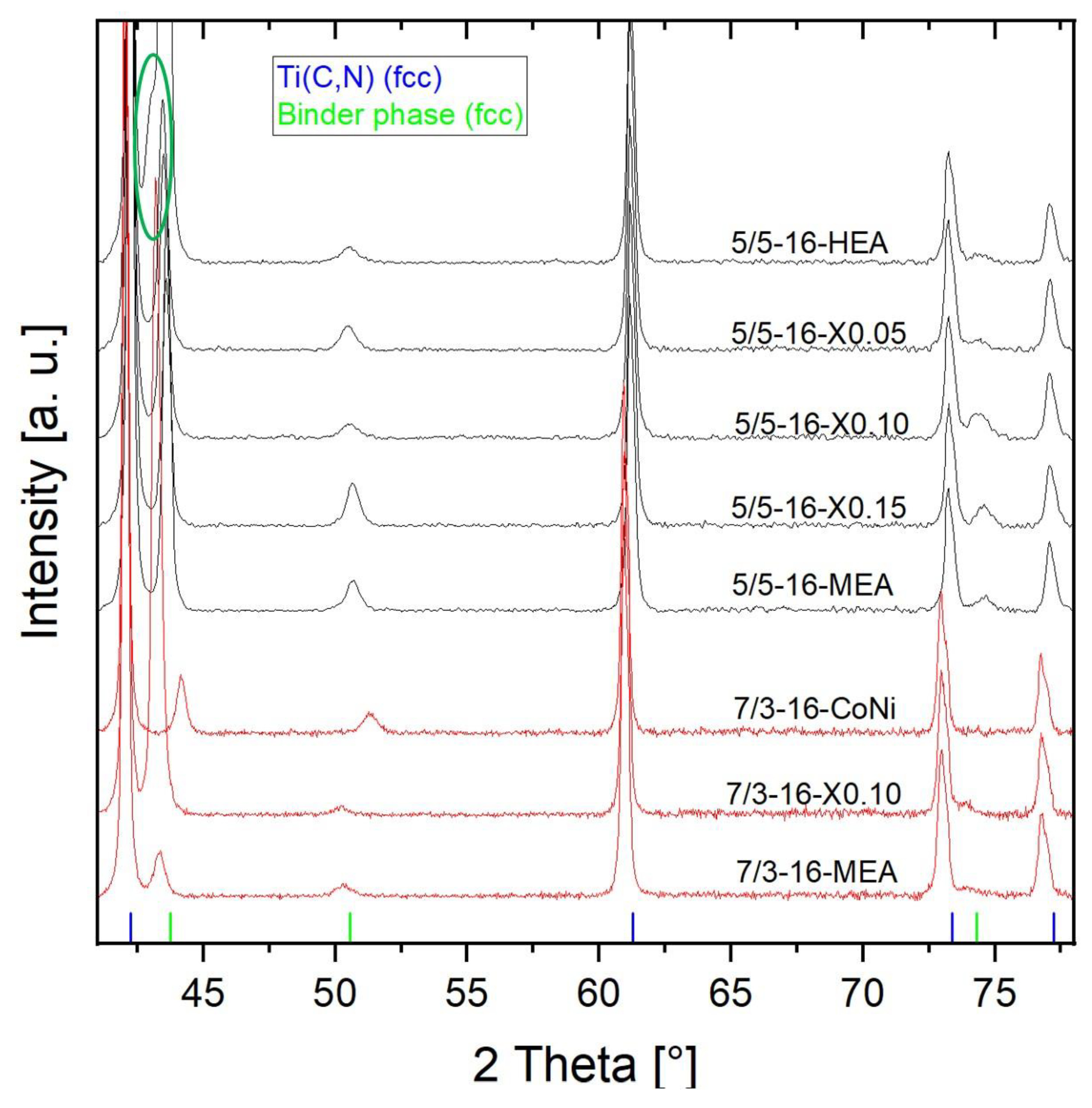
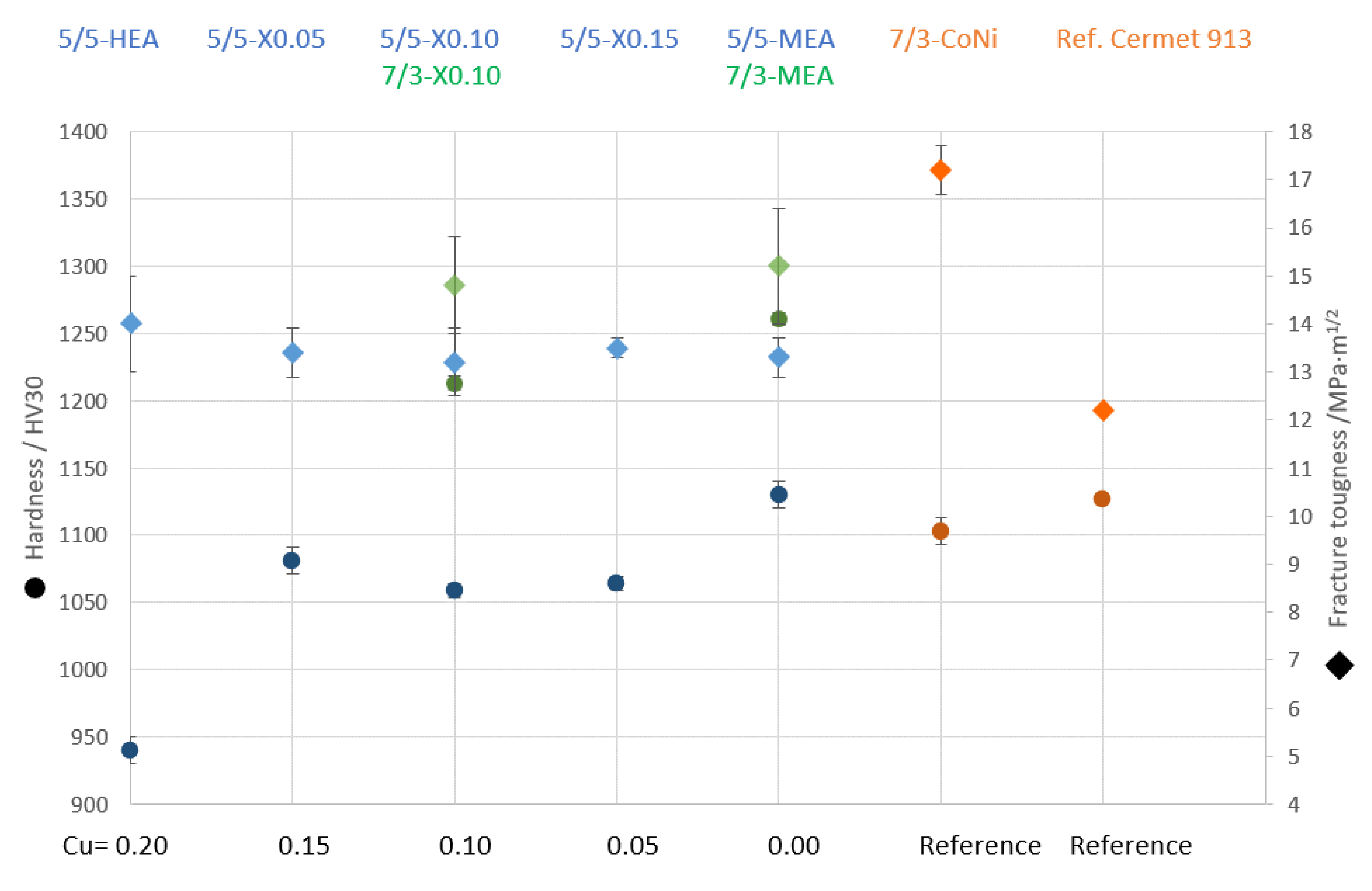
| Powder Designation | Producer/Source | Particle Size/dFSSS 1 in µm |
|---|---|---|
| TiCN 50/50 C | HCST Laufenburg | 1.3 |
| TiCN 70/30 C | HCST Laufenburg | 1.2 |
| Fe CIP HQ | BASF | 2.2 |
| Co S160 | Freeport Cobalt | 1.7 |
| Ni 2500 | Umicore | 2.3 |
| Mn 006020 | GoodFellow | 4.0 |
| Cu UCU-300 | CNPC | 1.2 |
| Sample ID | Binder Volume/vol% | Binder Composition /at-% | C/N Ratio /wt-% |
|---|---|---|---|
| 5/5-16-HEA | 16 | Mn0.2Fe0.2Co0.2Ni0.2Cu0.2 | 50/50 |
| 5/5-30-HEA | 30 | Mn0.2Fe0.2Co0.2Ni0.2Cu0.2 | 50/50 |
| 5/5-16-X0.05 | 16 | Mn0.2Fe0.2Co0.2Ni0.25Cu0.15 | 50/50 |
| 5/5-16-X0.10 | 16 | Mn0.2Fe0.2Co0.2Ni0.3Cu0.1 | 50/50 |
| 5/5-16-X0.15 | 16 | Mn0.2Fe0.2Co0.2Ni0.35 Cu0.05 | 50/50 |
| 5/5-16-MEA | 16 | Mn0.25Fe0.25Co0.25Ni0.25 | 50/50 |
| 7/3-16-X0.10 | 16 | Mn0.2Fe0.2Co0.2Ni0.3Cu0.1 | 70/30 |
| 7/3-16-MEA | 16 | Mn0.25Fe0.25Co0.25Ni0.25 | 70/30 |
| 7/3-16-CoNi | 16 | Co0.5Ni0.5 | 70/30 |
| Samples ID | Density/g/cm3 | Rel. Density/% | mS/µTm3kg−1 | Hc /kA/m | HV30 /- | K1C /MPa·m1/2 |
|---|---|---|---|---|---|---|
| 5/5-16-HEA | 5.68 | 99.9 | 14.3 ± 0.3 | 1.8 | 940 ± 10 | 14.0 ± 1.0 |
| 5/5-30-HEA | 6.00 | 97.7 | 20.9 ± 0.7 | 2.2 | 709 ± 15 | >18.0 1 |
| 5/5-16-X0.05 | 5.60 | 98.6 | 15.8 ± 0.4 | 1.2 | 1081 ± 10 | 13.4 ± 0.5 |
| 5/5-16-X0.10 | 5.61 | 98.7 | 16.9 ± 0.1 | 0.9 | 1059 ± 5 | 13.2 ± 0.7 |
| 5/5-16-X0.15 | 5.63 | 99.0 | 18.2 ± 0.1 | 0.7 | 1064 ± 5 | 13.5 ± 0.2 |
| 5/5-16-MEA | 5.60 | 98.9 | 20.6 ± 0.3 | 1.2 | 1130 ± 10 | 13.3 ± 0.4 |
| 7/3-16-X0.10 | 5.59 | 99.8 | 11.7 ± 0.6 | 0.6 | 1213 ± 4 | 14.8 ± 1.0 |
| 7/3-16-MEA | 5.56 | 99.7 | 14.6 ± 0.5 | 0.8 | 1261 ± 5 | 15.2 ± 1.2 |
| 7/3-16-CoNi | 5.66 | 99.8 | 34.4 ± 0.1 | 6.2 | 1103 ± 7 | 17.2 ± 0.5 |
| Ref. Cermet 913 [35] | - | - | - | - | 1127 ± - | 12.2 ± - |
| Sample | Phase | Lattice Parameter a/Å |
|---|---|---|
| 5/5-16-HEA | metal binder | 3.6055 ± 0.0001 |
| second metal binder | 3.6391 ± 0.0019 | |
| 5/5-16-X0.05 | metal binder | 3.6110 ± 0.0002 |
| 5/5-16-X0.10 | metal binder | 3.6090 ± 0.0002 |
| 5/5-16-X0.15 | metal binder | 3.6034 ± 0.0002 |
| 5/5-16-MEA | metal binder | 3.6002 ± 0.0002 |
Disclaimer/Publisher’s Note: The statements, opinions and data contained in all publications are solely those of the individual author(s) and contributor(s) and not of MDPI and/or the editor(s). MDPI and/or the editor(s) disclaim responsibility for any injury to people or property resulting from any ideas, methods, instructions or products referred to in the content. |
© 2023 by the authors. Licensee MDPI, Basel, Switzerland. This article is an open access article distributed under the terms and conditions of the Creative Commons Attribution (CC BY) license (https://creativecommons.org/licenses/by/4.0/).
Share and Cite
Pötschke, J.; Spalden, M.v.; Vornberger, A. TiCN Cermets with MnFeCoNiCu High Entropy Alloy Binder. Metals 2023, 13, 1259. https://doi.org/10.3390/met13071259
Pötschke J, Spalden Mv, Vornberger A. TiCN Cermets with MnFeCoNiCu High Entropy Alloy Binder. Metals. 2023; 13(7):1259. https://doi.org/10.3390/met13071259
Chicago/Turabian StylePötschke, Johannes, Mathias von Spalden, and Anne Vornberger. 2023. "TiCN Cermets with MnFeCoNiCu High Entropy Alloy Binder" Metals 13, no. 7: 1259. https://doi.org/10.3390/met13071259
APA StylePötschke, J., Spalden, M. v., & Vornberger, A. (2023). TiCN Cermets with MnFeCoNiCu High Entropy Alloy Binder. Metals, 13(7), 1259. https://doi.org/10.3390/met13071259






